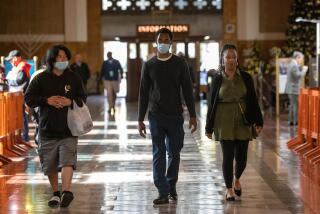SARS Virus Mapped, but Its Origins Still Unknown
U.S. and Canadian researchers have independently deciphered the complete genetic blueprint of the coronavirus now believed to be the cause of the mysterious pneumonia-like illness known as SARS. But to their immense disappointment, the structure has yielded no clues about the virus’ origin.
The new virus “is distinct from all other known coronaviruses, both animal and human,” said Dr. Julie L. Gerberding, director of the federal Centers for Disease Control and Prevention. “It is not similar enough to any known species to draw any conclusions about its origin.”
The rapid identification and blueprinting of the virus is “a scientific achievement that has never been paralleled in our history,” she said.
“You have to remember that it was only on March 13 that this disease was recognized,” added Dr. Marco Marra of the Michael Smith Genome Sciences Centre in British Columbia, where the blueprint was announced Sunday. “It’s breathtaking to see how quickly this virus was recognized and sequenced.”
The CDC announced its sequence Monday, and the two blueprints, researchers said, were virtually identical.
Deciphering the virus’ genome is expected to improve the quality of diagnostic tests for recognizing the presence of the virus and eventually might lead to the development of a treatment for the disease, formally known as severe acute respiratory syndrome. The discovery should also provide “genetic clues as to why this normally harmless family of viruses, which usually produces only very mild infections in humans, is producing such severe injury to the lung,” Marra said.
But researchers said the feat is unlikely to have any other immediate effect on controlling the spread of the disease. In particular, it will not speed the effort to develop an animal model of the disease or a vaccine.
Researchers had hoped that the blueprint would reveal one or more animal-linked genes that would identify the species in which the new virus emerged before it jumped to humans. Now, Gerberding said, researchers will be forced to rely on “old-fashioned shoe-leather epidemiology” to identify the source.
That will mean studying the first people who contracted the virus to determine with which animal species they might have come in contact, then looking for evidence of the virus in those animals, a process that could take weeks or months.
Monday marked one month since the CDC’s activation of its emergency response center to deal with SARS, and the day brought what Gerberding termed “mixed news.” In much of the world, including Taiwan, the United States and Canada, “it looks like the outbreak has been contained,” she said. Almost all the new cases of the disease in these regions are among “travelers arriving from affected areas.”
But the situation is far different in mainland China and Hong Kong, which have been the focus of the outbreak. According to the World Health Organization, China on Monday reported 109 new probable cases of SARS and six deaths, bringing its cumulative total to 1,418 cases and 64 deaths. The largest number of new cases, 47, occurred in Shanxi province, suggesting that the disease is spreading to China’s interior from its origination in Guangdong province in the south. Two other regions have also reported SARS cases: 10 in the Inner Mongolia and three in coastal Fujian province.
Authorities within China and outside the country fear that the poorer regions will have difficulty coping with the disease.
China has long maintained that it had the disease under control, but that attitude seems to be changing. Premier Wen Jiabao said Sunday: “Much progress has been made in combating the disease ... but the overall situation remains grave.”
Hong Kong on Monday reported seven new deaths from the disease -- its largest one-day total -- bringing its cumulative number to 47. The city also reported 40 new cases, bringing its total to 1,190.
Health officials in the city are particularly concerned because six of the SARS deaths over the weekend occurred in younger victims, ages 35 to 52, who apparently had no underlying illnesses. Most previous fatalities had occurred in patients who were already debilitated, and the deaths of the younger, healthier patients suggest that the outbreak may be shifting into a new phase, perhaps as the result of a mutation in the virus.
Hong Kong physicians have begun using heavier doses of medications during SARS’ early stages in an effort to forestall further deaths among the healthy, but drugs have been found to provide only minimal benefit in fighting off the infection.
Elsewhere, the first possible cases of SARS were reported in Indonesia, the Philippines, Sweden and South Africa.
As of Monday, WHO said there were 3,169 cases of SARS worldwide and 144 deaths.
The CDC noted 193 probable and suspected cases in the United States. Gerberding said that number would begin changing erratically later in the week as state health authorities begin using new diagnostic tests for the coronavirus. The CDC “has been casting a wide net” in including suspected cases in its continuing count, and many of those suspected cases undoubtedly will be found to have other causes, she noted.






